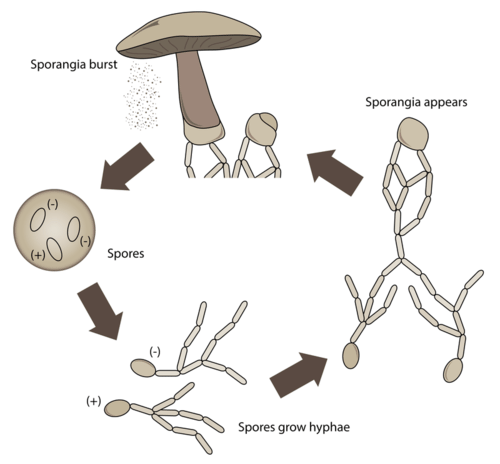OVERVIEW/STRUCTURE
Some fungi are multicellular organisms while others (like yeast) are unicellular organisms. They have similarities with bacteria, as well as similarities with animals and plants. Therefore, they are their own kingdom.Fungi can be very useful to humans, as they can be a food source (mushrooms and truffles), used to make food/drink (blue cheeses, ginger beer, alcoholic drinks, bread...), and make antibiotic chemicals that we can use to treat bacterial diseases.
Unfortunately, fungi can also be problematic to humans. They can cause diseases, such as Athlete's Foot. They can spoil our food (bread mould, jam mould...). Because their cell structure is so similar to ours, fungal diseases are difficult to treat. Because we only usually notice fungi on our food when we see their sporangia, we do not know how far into our food they have spread.
By understanding the structure and life processes of fungi, we can learn how to use them to our advantage, and how to deal with them when they cause disease or spoil our food.
GROWTH AND REPRODUCTION (Budding and Spores)
SPORES
Multicellular fungi reproduce by creating spores. These can be carried away by vectors (the wind, water, animals...) to a new food source where they create a new fungus.

BUDDING
In contrast, unicellular fungi (yeast) reproduce by doing a process called budding. It is very similar to binary fission in bacteria.
NUTRITION (Extracellular Digestion)
Like bacteria, fungi release enzymes to break food down outside their cells. They then absorb the digested food into their cells to be used as Nutrition.

FUNGAL DISEASES
Fungal diseases are some of the most difficult to treat. Genetically, fungi are closer to animals (like us) than bacteria or plants. That means most things that kill fungi also harm us (or plants that we want to protect from the fungus). Not ideal!!!
Just watch the first 1:45 of this. The rest is about another type of pathogenic Kingdom, called the Protists:
USES OF FUNGI
1. Food Industry
This is not the most engaging video, but it does give a very good overview of some of the key uses of fungi in the food industry.
2. Antibiotics
Antibiotics were actually discovered by accident. A fungus contaminated an experiment involving bacteria. Now, fungi are one of the main sources of our common antibiotics used to fight bacterial diseases.
3. The Future
SYMBIOSIS AND OTHER SUPERPOWERS
Fungi are amazing in the relationships they have with other organisms, especially plants. These videos are really only for those interested in learning more about the wonderful world of fungi:




